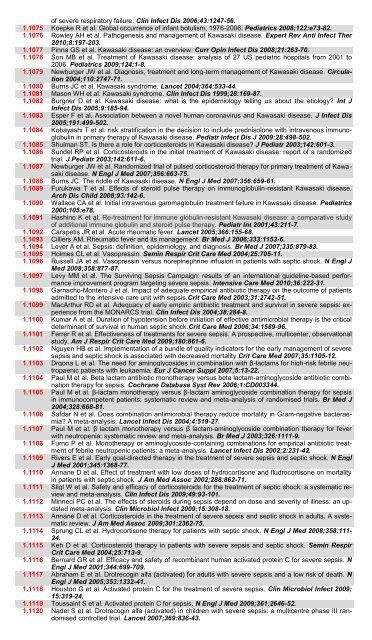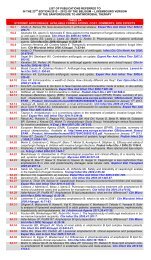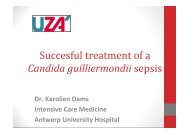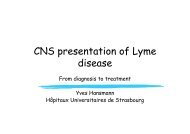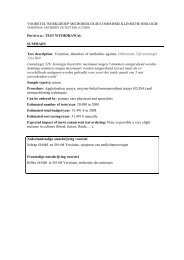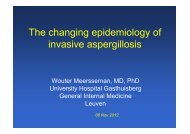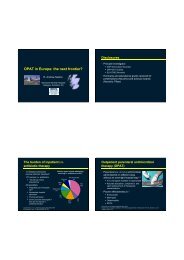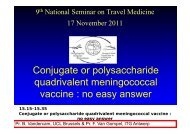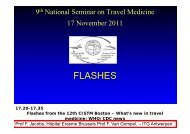TABLE 39A LIST OF PUBLICATIONS REFERRED TO IN THE ...
TABLE 39A LIST OF PUBLICATIONS REFERRED TO IN THE ...
TABLE 39A LIST OF PUBLICATIONS REFERRED TO IN THE ...
You also want an ePaper? Increase the reach of your titles
YUMPU automatically turns print PDFs into web optimized ePapers that Google loves.
of severe respiratory failure. Clin Infect Dis 2006;43:1247-56.<br />
1.1075 Koepke R et al. Global occurrence of infant botulism, 1976-2006. Pediatrics 2008;122:e73-82.<br />
1.1076 Rowley AH et al. Pathogenesis and management of Kawasaki disease. Expert Rev Anti Infect Ther<br />
2010;8:197-203.<br />
1.1077 Pinna GS et al. Kawasaki disease: an overview. Curr Opin Infect Dis 2008;21:263-70.<br />
1.1078 Son MB et al. Treatment of Kawasaki disease: analysis of 27 US pediatric hospitals from 2001 to<br />
2006. Pediatrics 2009;124:1-8.<br />
1.1079 Newburger JW et al. Diagnosis, treatment and long-term management of Kawasaki disease. Circulation<br />
2004;110:2747-71.<br />
1.1080 Burns JC et al. Kawasaki syndrome. Lancet 2004;364:533-44.<br />
1.1081 Mason WH et al. Kawasaki syndrome. Clin Infect Dis 1999;28:169-87.<br />
1.1082 Burgner D et al. Kawasaki disease: what is the epidemiology telling us about the etiology? Int J<br />
Infect Dis 2005;9:185-94.<br />
1.1083 Esper F et al. Association between a novel human coronavirus and Kawasaki disease. J Infect Dis<br />
2005;191:499-502.<br />
1.1084 Kobayashi T et al. risk stratification in the decision to include prednisolone with intravenous immunoglobulin<br />
in primary therapy of Kawasaki disease. Pediatr Infect Dis J 2009;28:498-502.<br />
1.1085 Shulman ST. Is there a role for corticosteroids in Kawasaki disease? J Pediatr 2003;142:601-3.<br />
1.1086 Sundel RP et al. Corticosteroids in the initial treatment of Kawasaki disease: report of a randomized<br />
trial. J Pediatr 2003;142:611-6.<br />
1.1087 Newburger JW et al. Randomized trial of pulsed corticosteroid therapy for primary treatment of Kawasaki<br />
disease. N Engl J Med 2007;356:663-75.<br />
1.1088 Burns JC. The riddle of Kawasaki disease. N Engl J Med 2007;356:659-61.<br />
1.1089 Furukawa T et al. Effects of steroid pulse therapy on immunoglobulin-resistant Kawasaki disease.<br />
Arch Dis Child 2008;93:142-6.<br />
1.1090 Wallace CA et al. Initial intravenous gammaglobulin treatment failure in Kawasaki disease. Pediatrics<br />
2000;105:e78.<br />
1.1091 Hashino K et al. Re-treatment for immune globulin-resistant Kawasaki disease: a comparative study<br />
of additional immune globulin and steroid pulse therapy. Pediatr Int 2001;43:211-7.<br />
1.1092 Carapetis JR et al. Acute rheumatic fever. Lancet 2005;366:155-68.<br />
1.1093 Cilliers AM. Rheumatic fever and its management. Br Med J 2006;333:1153-6.<br />
1.1094 Lever A et al. Sepsis: definition, epidemiology, and diagnosis. Br Med J 2007;335:879-83.<br />
1.1095 Holmes CL et al. Vasopressin. Semin Respir Crit Care Med 2004;25:705-11.<br />
1.1096 Russell JA et al. Vasopressin versus norepinephrine infusion in patients with septic shock. N Engl J<br />
Med 2008;358:877-87.<br />
1.1097 Levy MM et al. The Surviving Sepsis Campaign: results of an international guideline-based performance<br />
improvement program targeting severe sepsis. Intensive Care Med 2010;36:222-31.<br />
1.1098 Garnacho-Montero J et al. Impact of adequate empirical antibiotic therapy on the outcome of patients<br />
admitted to the intensive care unit with sepsis.Crit Care Med 2003;31:2742-51.<br />
1.1099 MacArthur RD et al. Adequacy of early empiric antibiotic treatment and survival in severe sepsis: experience<br />
from the MONARCS trial. Clin Infect Dis 2004;38:284-8.<br />
1.1100 Kumar A et al. Duration of hypotension before initiation of effective antimicrobial therapy is the critical<br />
determinant of survival in human septic shock.Crit Care Med 2006;34:1589-96.<br />
1.1101 Ferrer R et al. Effectiveness of treatments for severe sepsis. A prospective, multicenter, observational<br />
study. Am J Respir Crit Care Med 2009;180:861-6.<br />
1.1102 Nguyen HB et al. Implementation of a bundle of quality indicators for the early management of severe<br />
sepsis and septic shock is associated with decreased mortality.Crit Care Med 2007;35:1105-12.<br />
1.1103 Drgona L et al. The need for aminoglycosides in combination with β-lactams for high-risk febrile neutropaenic<br />
patients with leukaemia. Eur J Cancer Suppl 2007;5:13-22.<br />
1.1104 Paul M et al. Beta lactam antibiotic monotherapy versus beta lactam-aminoglycoside antibiotic combination<br />
therapy for sepsis. Cochrane Database Syst Rev 2006;1:CD003344.<br />
1.1105 Paul M et al. β-lactam monotherapy versus β-lactam aminoglycoside combination therapy for sepsis<br />
in immunocompetent patients: systematic review and meta-analysis of randomised trials. Br Med J<br />
2004;328:668-81.<br />
1.1106 Safdar N et al. Does combination antimicrobial therapy reduce mortality in Gram-negative bacteraemia?<br />
A meta-analysis. Lancet Infect Dis 2004;4:519-27.<br />
1.1107 Paul M et al. β lactam monotherapy versus β lactam-aminoglycoside combination therapy for fever<br />
with neutropenia: systematic review and meta-analysis. Br Med J 2003;326:1111-9.<br />
1.1108 Furno P et al. Monotherapy or aminoglycoside-containing combinations for empirical antibiotic treatment<br />
of febrile neutropenic patients: a meta-analysis. Lancet Infect Dis 2002;2:231-42.<br />
1.1109 Rivers E et al. Early goal-directed therapy in the treatment of severe sepsis and septic shock. N Engl<br />
J Med 2001;345:1368-77.<br />
1.1110 Annane D et al. Effect of treatment with low doses of hydrocortisone and fludrocortisone on mortality<br />
in patients with septic shock. J Am Med Assoc 2002;288:862-71.<br />
1.1111 Sligl W et al. Safety and efficacy of corticosteroids for the treatment of septic shock: a systematic review<br />
and meta-analysis. Clin Infect Dis 2009;49:93-101.<br />
1.1112 Minneci PC et al. The effects of steroids during sepsis depend on dose and severity of illness: an updated<br />
meta-analysis. Clin Microbiol Infect 2009;15:308-18.<br />
1.1113 Annane D et al. Corticosteroids in the treatment of severe sepsis and septic shock in adults. A systematic<br />
review. J Am Med Assoc 2009;301:2362-75.<br />
1.1114 Sprung CL et al. Hydrocortisone therapy for patients with septic shock. N Engl J Med 2008;358:111-<br />
24.<br />
1.1115 Keh D et al. Corticosteroid therapy in patients with severe sepsis and septic shock. Semin Respir<br />
Crit Care Med 2004;25:713-9.<br />
1.1116 Bernard GR et al. Efficacy and safety of recombinant human activated protein C for severe sepsis. N<br />
Engl J Med 2001;344:699-709.<br />
1.1117 Abraham E et al. Drotrecogin alfa (activated) for adults with severe sepsis and a low risk of death. N<br />
Engl J Med 2005;353:1332-41.<br />
1.1118 Houston G et al. Activated protein C for the treatment of severe sepsis. Clin Microbiol Infect 2009;<br />
15:319-24.<br />
1.1119 Toussaint S et al. Activated protein C for sepsis. N Engl J Med 2009;361:2646-52.<br />
1.1120 Nadel S et al. Drotrecogin alfa (activated) in children with severe sepsis: a multicentre phase III randomised<br />
controlled trial. Lancet 2007;369:836-43.


